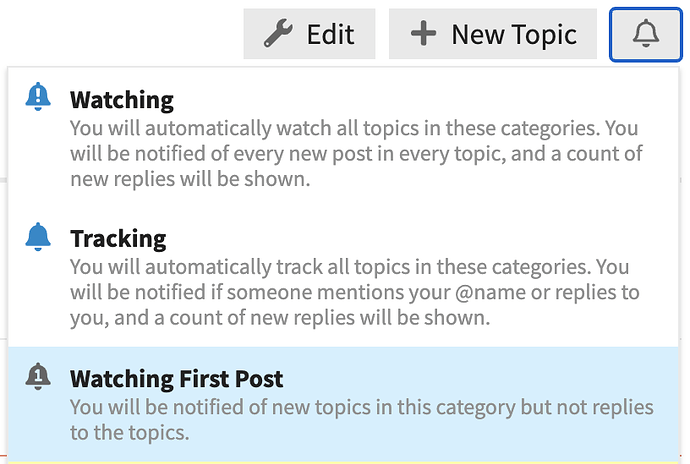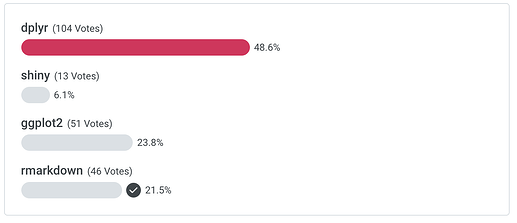If you'd like to start a new discussion under Finance, go to Finance , and click "New Topic".
To follow new Finance posts, be sure to at least click "Watching First Post" on Finance.

Recap
Here's a recap of some of the Social feed activity related to Finance at rstudio::global(2021). Please join in continuing the discussion and connecting with other R users in finance below!
Q&A: What’s the biggest challenge you face as an R user in finance?
I work in Utilities sector managing a commodity trading desk and the biggest challenge we face is modernization of tools and operational software. As Nick Rohrbaugh mentions above, Excel is the "tried and true" industry standard for most and the struggle is convincing people that moving to a programmatic solution (R, Python, etc.) is worth the effort. This is especially true for smaller Utilities that may not have the budget to instantiate a Data Science/Analytics team. On the bright side, we seem to be on the precipice of a paradigm shift with organizations like Utility Analytics Institute (UAI) and others.
I've found that almost all of my research is on time series, for which R has a ton of solutions (zoo::rollapply; tibbletime, etc). The problem I've had in the past is finding solutions that fit well in the tidyverse (so not rollapply) without completely transforming the source data (which tibbletime requires). I'm going to take this opportunity to upvote slider, which I just discovered in the last few weeks. Excellent package for rolling operations, follows tidy syntax and is really fast.
... After 5 years of small examples, I still have to convince the management to upscale from "coding on my local computer" to having a fully functioning production environment that includes data sourcing, data pipelines, data modifications and automating reporting.
They still see it as a "would be nice to have, still that is not our core business and we don't want to open data analytics positions in the company"
This is an extremely interesting thread. I identify a great deal with the problems mentioned here. I think R is now in a good place for time series analysis, with lots of packages providing tools to work with it. But I think finance is about more than time series. I think of finance primarily in terms of 'contracts'. These can be stocks, bonds, derivatives etc, but they can also be insurance, subscriptions, bank deposits etc. And although R has the capability to these things (via tools like RQuantLib), they aren't as easy or tidy as they could be. And it's hard to get them to mesh well with the tools of the Tidyverse.
Getting people out of Excel... "But I can't program!"... "um, you've spent 15 years on Excel.. you got this!"
Poll: If you could use only one of these packages for the rest of your life, which would it be?
A selection of comments:
- How could you make me choose?
(Shiny is the one I'd have the hardest time replicating or just getting things done without)
- Dplyr because I've already forgotten how to use R Base
- Ha! I would feel helpless without dplyr but could probably re-learn base R or some data.table eventually. But R Markdown will always have a special place in my heart
- .rmd because it keeps swallowing up other functionality so I could get more and more over time!
- dplyr, before any visualization, app, modeling, or documentation we need first to manipulate and tidy data!
- dplyr because without it supportable code is a challenge.
- I prefer tidy syntax to data.table, but in a pinch, I could do without dplyr. I find that in our field, sharing research with laypeople is the most challenging obstacles. rmarkdown would be hard for me to do without from that standpoint
- rmarkdown because ggplot and dplyr functionality can be done other ways and shiny is more of a (very good) niche application. rmarkdown is ubiquitous!
- Great to see the rmarkdown love. I like to think that I could learn enough JavaScript to make Rmd powerful enough that I don't miss Shiny too much, and I'm happy to leave that idea untested for now.
- dplyr, tough call but it's just too essential!
- Love all the tidyverse. But can't massage that data for ggplot without first saying hello to dplyr!
- Although painful, I can live without dplyr but not ggplot2.
- I would throw in tidyr. A lot of dlpyr functionality is available in SQL/pandas (though not nearly as use-friendly, IMO). tidyr stands alone in its ability to reshape data.
- I would miss ggplot2 but would be fine with plotly
- Very difficult choice! I think I could find other ways of filtering/manipulating my data (not as elegantly of course) without dplyr, I would definitely miss rmarkdown, but I think I don't see a way of doing beautiful figures without ggplot. I have play with but never used shiny yet.
- I definitely agree with you. I could use base R for subsetting if need be. It's a tie between ggplot and rmarkdown. I chose Rmd because it's unbelievably powerful for things like making websites, books, documenting, etc.
- It's nice to see the results not too different from the CRAN download trends:
https://hadley.shinyapps.io/cran-downloads/
Q&A: What are some resources for jumping into the world of R for finance?
A few resources mentioned in various Social threads:
Blogs
- Reproducible Finance
- The CuRious Financial Risk ManageR
- Finance category on R Views
- QuantStrat TradeR
Per Joe Rickert, R Views welcomes guest posts on financial applications of R. Let us know if you're interested!
Packages
- CRAN Task View for Empirical Finance
- Finance: tidyquant, quantmod, RQuantLib, PortfolioAnalytics
- Time series: timetk, modeltime, forecast, xts
